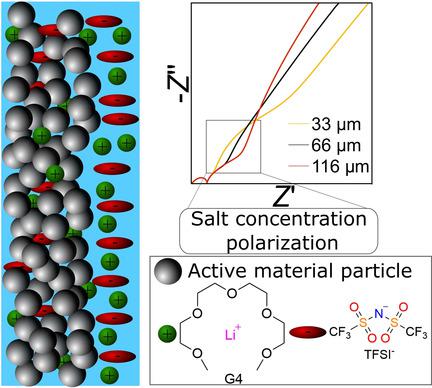当前位置:
X-MOL 学术
›
Batteries Supercaps
›
论文详情
Our official English website, www.x-mol.net, welcomes your feedback! (Note: you will need to create a separate account there.)
Thickness‐Dependent Impedance of Composite Battery Electrodes Containing Ionic Liquid‐Based Electrolytes
Batteries & Supercaps ( IF 5.7 ) Pub Date : 2020-03-02 , DOI: 10.1002/batt.202000023 Marvin Cronau 1 , Moritz Kroll 1 , Marvin Szabo 1 , Fabian Sälzer 1 , Bernhard Roling 1
Batteries & Supercaps ( IF 5.7 ) Pub Date : 2020-03-02 , DOI: 10.1002/batt.202000023 Marvin Cronau 1 , Moritz Kroll 1 , Marvin Szabo 1 , Fabian Sälzer 1 , Bernhard Roling 1
Affiliation

|
Lithium‐ion battery models often neglect the salt concentration polarization inside the electrolyte‐filled pores of the composite electrodes. However, this concentration polarization causes a significant impedance, in particular in the case of electrolytes with low Li+ transference numbers. Here, we analyze in detail measured and calculated impedance spectra of composite electrodes containing a solvate ionic liquid‐based electrolyte and an ionic liquid‐based electrolyte, respectively, in comparison to a conventional carbonate‐based electrolyte. For calculating spectra, we use a recently published model by Huang and Zhang. We find that the impedance at 10−4 Hz, which is relevant for battery cycling rates around 1 C to 2 C, increases in the order carbonate‐based electrolyte<ionic liquid‐based electrolyte<solvate ionic liquid‐based electrolytes, but exhibits a remarkably weak thickness dependence, when the electrode thickness exceeds 50–100 μm. This suggests that electrodes considerably thicker than the conventional 80 μm can be used in batteries without significantly deteriorating battery power.
中文翻译:

含离子液体基电解质的复合电池电极的厚度依赖性阻抗
锂离子电池模型通常会忽略复合电极填充电解质的孔内的盐浓度极化。但是,这种浓差极化会引起很大的阻抗,特别是在电解质具有低Li +传递数的情况下。在这里,我们与传统的基于碳酸盐的电解质相比,分别详细分析和计算了分别包含溶剂化离子液体电解质和离子液体电解质的复合电极的阻抗谱。为了计算光谱,我们使用Huang和Zhang最近发布的模型。我们发现阻抗为10 -4 Hz与大约1 C到2 C左右的电池循环速率有关,以碳酸盐基电解质<离子液体基电解质<溶剂化物离子液体基电解质的顺序增加,但当电极厚度变化时,对厚度的依赖性非常弱超过50–100μm。这表明可以在电池中使用比常规80μm厚得多的电极,而不会显着降低电池功率。
更新日期:2020-03-02
中文翻译:

含离子液体基电解质的复合电池电极的厚度依赖性阻抗
锂离子电池模型通常会忽略复合电极填充电解质的孔内的盐浓度极化。但是,这种浓差极化会引起很大的阻抗,特别是在电解质具有低Li +传递数的情况下。在这里,我们与传统的基于碳酸盐的电解质相比,分别详细分析和计算了分别包含溶剂化离子液体电解质和离子液体电解质的复合电极的阻抗谱。为了计算光谱,我们使用Huang和Zhang最近发布的模型。我们发现阻抗为10 -4 Hz与大约1 C到2 C左右的电池循环速率有关,以碳酸盐基电解质<离子液体基电解质<溶剂化物离子液体基电解质的顺序增加,但当电极厚度变化时,对厚度的依赖性非常弱超过50–100μm。这表明可以在电池中使用比常规80μm厚得多的电极,而不会显着降低电池功率。


























 京公网安备 11010802027423号
京公网安备 11010802027423号